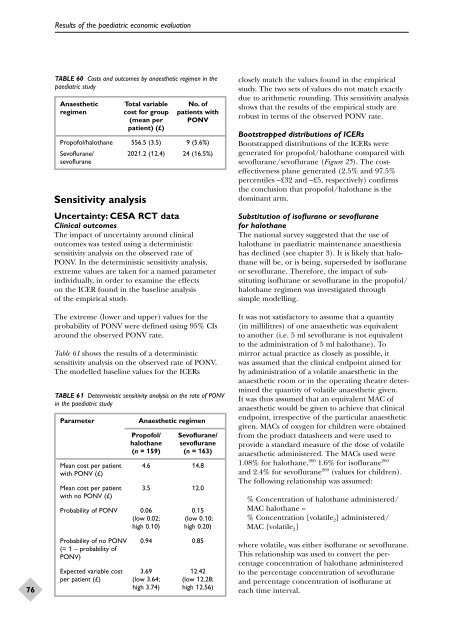Aanesthetic Agents for Day Surgery - NIHR Health Technology ...
Aanesthetic Agents for Day Surgery - NIHR Health Technology ...
Aanesthetic Agents for Day Surgery - NIHR Health Technology ...
You also want an ePaper? Increase the reach of your titles
YUMPU automatically turns print PDFs into web optimized ePapers that Google loves.
76<br />
Results of the paediatric economic evaluation<br />
TABLE 60 Costs and outcomes by anaesthetic regimen in the<br />
paediatric study<br />
Anaesthetic Total variable No. of<br />
regimen cost <strong>for</strong> group patients with<br />
(mean per PONV<br />
patient) (£)<br />
Propofol/halothane 556.5 (3.5) 9 (5.6%)<br />
Sevoflurane/<br />
sevoflurane<br />
2021.2 (12.4) 24 (16.5%)<br />
Sensitivity analysis<br />
Uncertainty: CESA RCT data<br />
Clinical outcomes<br />
The impact of uncertainty around clinical<br />
outcomes was tested using a deterministic<br />
sensitivity analysis on the observed rate of<br />
PONV. In the deterministic sensitivity analysis,<br />
extreme values are taken <strong>for</strong> a named parameter<br />
individually, in order to examine the effects<br />
on the ICER found in the baseline analysis<br />
of the empirical study.<br />
The extreme (lower and upper) values <strong>for</strong> the<br />
probability of PONV were defined using 95% CIs<br />
around the observed PONV rate.<br />
Table 61 shows the results of a deterministic<br />
sensitivity analysis on the observed rate of PONV.<br />
The modelled baseline values <strong>for</strong> the ICERs<br />
TABLE 61 Deterministic sensitivity analysis on the rate of PONV<br />
in the paediatric study<br />
Parameter Anaesthetic regimen<br />
Propofol/ Sevoflurane/<br />
halothane sevoflurane<br />
(n = 159) (n = 163)<br />
Mean cost per patient 4.6 14.8<br />
with PONV (£)<br />
Mean cost per patient 3.5 12.0<br />
with no PONV (£)<br />
Probability of PONV 0.06 0.15<br />
(low 0.02; (low 0.10;<br />
high 0.10) high 0.20)<br />
Probability of no PONV 0.94 0.85<br />
(= 1 – probability of<br />
PONV)<br />
Expected variable cost 3.69 12.42<br />
per patient (£) (low 3.64; (low 12.28;<br />
high 3.74) high 12.56)<br />
closely match the values found in the empirical<br />
study. The two sets of values do not match exactly<br />
due to arithmetic rounding. This sensitivity analysis<br />
shows that the results of the empirical study are<br />
robust in terms of the observed PONV rate.<br />
Bootstrapped distributions of ICERs<br />
Bootstrapped distributions of the ICERs were<br />
generated <strong>for</strong> propofol/halothane compared with<br />
sevoflurane/sevoflurane (Figure 25). The costeffectiveness<br />
plane generated (2.5% and 97.5%<br />
percentiles –£32 and –£5, respectively) confirms<br />
the conclusion that propofol/halothane is the<br />
dominant arm.<br />
Substitution of isoflurane or sevoflurane<br />
<strong>for</strong> halothane<br />
The national survey suggested that the use of<br />
halothane in paediatric maintenance anaesthesia<br />
has declined (see chapter 3). It is likely that halothane<br />
will be, or is being, superseded by isoflurane<br />
or sevoflurane. There<strong>for</strong>e, the impact of substituting<br />
isoflurane or sevoflurane in the propofol/<br />
halothane regimen was investigated through<br />
simple modelling.<br />
It was not satisfactory to assume that a quantity<br />
(in millilitres) of one anaesthetic was equivalent<br />
to another (i.e. 5 ml sevoflurane is not equivalent<br />
to the administration of 5 ml halothane). To<br />
mirror actual practice as closely as possible, it<br />
was assumed that the clinical endpoint aimed <strong>for</strong><br />
by administration of a volatile anaesthetic in the<br />
anaesthetic room or in the operating theatre determined<br />
the quantity of volatile anaesthetic given.<br />
It was thus assumed that an equivalent MAC of<br />
anaesthetic would be given to achieve that clinical<br />
endpoint, irrespective of the particular anaesthetic<br />
given. MACs of oxygen <strong>for</strong> children were obtained<br />
from the product datasheets and were used to<br />
provide a standard measure of the dose of volatile<br />
anaesthetic administered. The MACs used were<br />
1.08% <strong>for</strong> halothane, 260 1.6% <strong>for</strong> isoflurane 260<br />
and 2.4% <strong>for</strong> sevoflurane 260 (values <strong>for</strong> children).<br />
The following relationship was assumed:<br />
% Concentration of halothane administered/<br />
MAC halothane =<br />
% Concentration [volatile 2] administered/<br />
MAC [volatile 2]<br />
where volatile 2 was either isoflurane or sevoflurane.<br />
This relationship was used to convert the percentage<br />
concentration of halothane administered<br />
to the percentage concentration of sevoflurane<br />
and percentage concentration of isoflurane at<br />
each time interval.
















